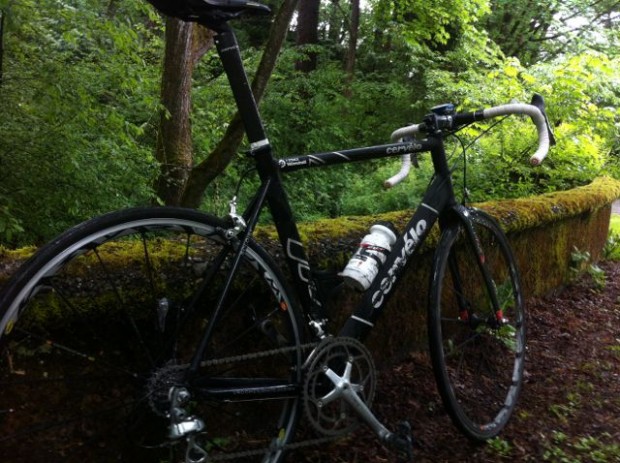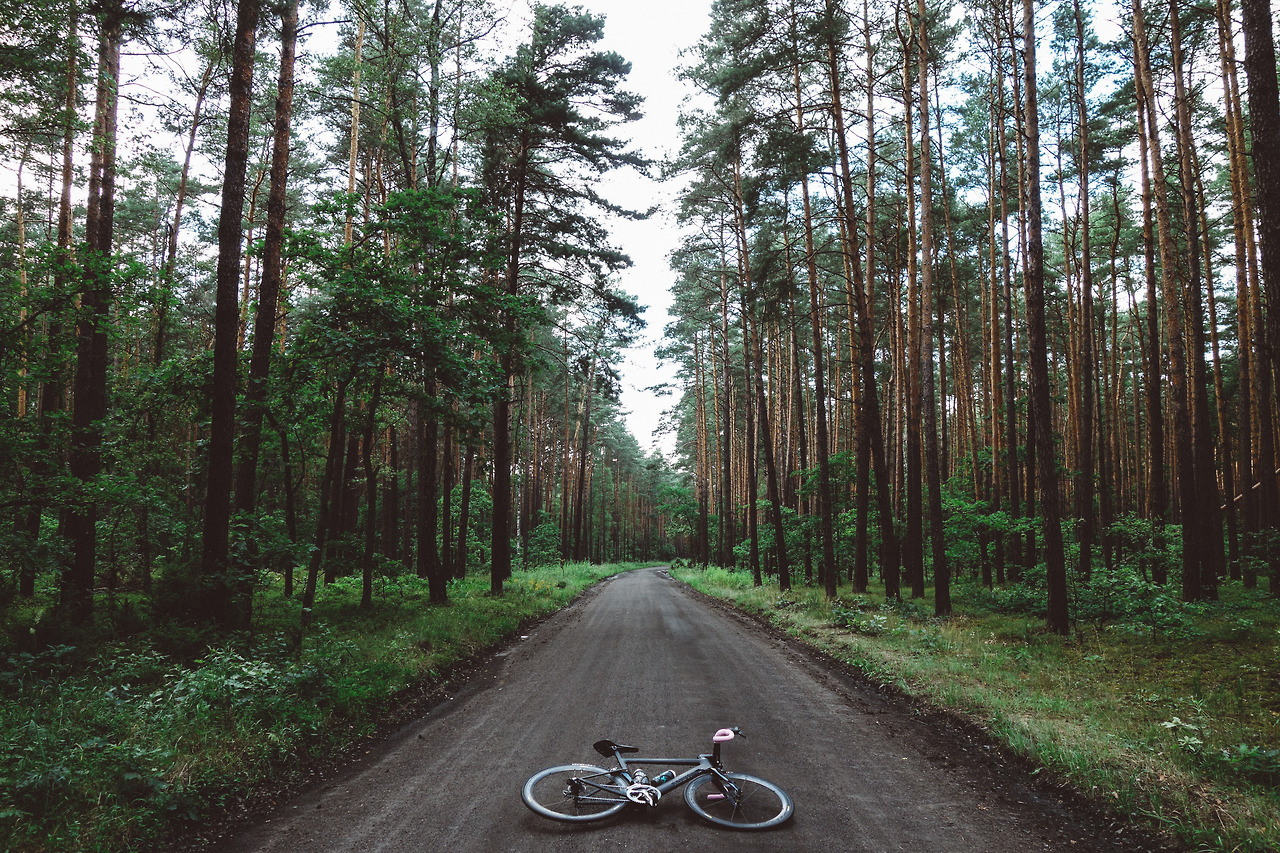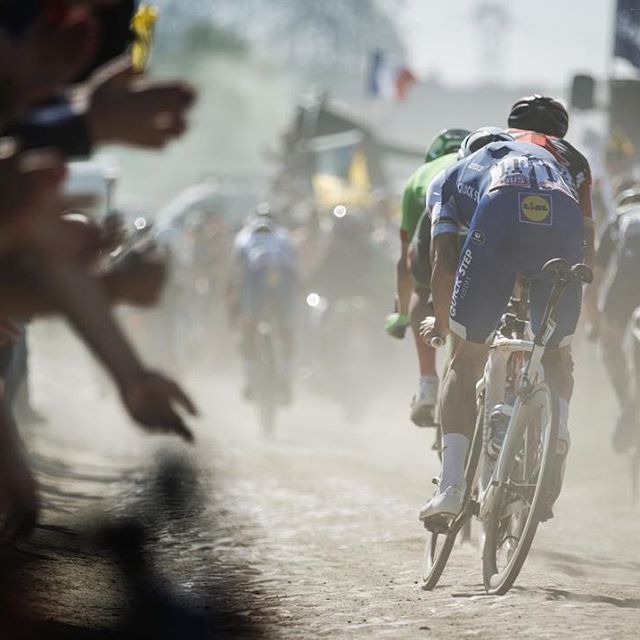La Vie Velominatus: The Rain Bike

In our privileged stables of bikes, it ranks towards the bottom of the heap as Bike #2 or lower, but the Rain Bike is no slouch. This is, after all, the bike we rely on in bad weather, trusting it to carry us safely through what typically amounts to the most dangerous conditions we ride in. Provided you ride year-round, you likely ride this machine more often than your Number One – assuming you live in an environment that isn’t a tropical island (I’m looking at you @gianni) or classified as a desert. It follows, then, that this is a machine to be curated with great care and several factors should be kept in mind when selecting the machine for this wet and dirty work.
The first consideration is the material. I hope I’m not spoiling anyone’s fantasy by pointing out that rain isn’t actually made of the sweat falling from Merckx’s guns as he pedals high up on Mount Velomis; it is mostly water, mixed with some acids and other crap. Rain water can cause certain kinds of materials to become compromised in one way or another. Steel, for example, is particularly prone to this through rusting. Calfee’s bamboo frames might be susceptible to becoming soggy – I’m not sure. For a bike which is to be ridden primarily in wet conditions, choose a durable, non-corrosive material like titanium, aluminum or carbon.
The second consideration is the components. Here’s the other news flash about riding in the rain: the roads are less pristine than they are in the dry. Road grit gets in your drivetrain and on on your rims, acting like coarse sandpaper to accelerate wear. Since you’ll be replacing some parts more often than on a bike ridden in the dry, this is a bike for which to get economical about gear selection; you aren’t going to want to replace your full titanium Super-Record cassette and chain after it wears out in 1/3 the time. The shifters, brakes, crankset, and derailleurs don’t have to be greatly affected provided you maintain the bike in the style of a velominatus, but the wheels, bottom bracket, derailleur pulleys, chain, cassette and freehub will certainly feel the strain. Anything that moves, has a bearing, or lets water in is a candidate for accelerated wear.
Third, this has to be a bike you’re going to love riding, not some beater that gets abused and you tolerate throwing your leg over. As much as riding in Rule #9 conditions is badass and an invigorating experience, it does get a bit tiresome when you ride in the rain every day from October to March (or May, for you Pacific-Northwesterners). If your position isn’t right and if the bike isn’t a pleasure to ride, it’s not going to make getting cold and wet any more enjoyable.
Lastly, this bike will be taking abuse, so remember that your safety is entrusted to this machine in conditions when visibility is low, stopping distances increased, and road surfaces slick. Maintain this bike more diligently than any other machine; check the brake pads and rims for dangerous wear, check the metal bits for rust and cracks, and keep a close eye on the chain and cables. Resist the temptation to spray it down with the garden hose as the pressure can lodge the grit deeper into bearings and other nooks and crannies on the bike. After each ride, clean the braking surfaces carefully, wipe the chain down (or, better yet, use a Cyclone with soapy water to get the grit out from in between the links) and always use a wax-based lubricant to keep the dirt from sticking to it more than with traditional oil-based lubes.
But most of all, remember that the best kind of ride is the one you’ll be able to do again; stay safe and ride carefully. Vive la Vie Velominatus.
[dmalbum path=”/velominati.com/content/Photo Galleries/frank@velominati.com/LVV Rain Bike/”/]


@Frank
Apologies, but I wasn’t being as rude or disrespectful as you think: on this side of the pond, “my arse” is tagged on the end of sentences to express incredulity, as in “A dope free TDF? My arse!”
You are, however, more than welcome to kiss my arse should the occasion arise, but bearing in mind the biblical weather we’re having, a brisk rub-down with a damp copy of the Sporting Life would be prefered!
@Nate
We had this chat awhile ago. Was it Marcus who watched the rest of the breakaway leave him behind because his HRM told him he was already at his limit? Or was it Marcus who lambasted some poor buffoon who made this excuse? How often do you think JENS looks at his HRM? And is it at or beyond threshold that he shouts “shut up legs.”? Just asking…
@RedRanger
Are you standing beside a black helicopter?
@the Engine
nope, just an old ass 727
@frank
My Cateye wireless dofer has a habit of randomly turning itself into a V-Meter for no apparent reason. One minute all is well and then the screen lights up every liquid crystal, then it switches off, then it asks for units and then it goes back to the factory default anything from 10 minutes to three days later. Both my Cateyes do this and it isn’t the batteries so from time to time a big V decal is all there is.
I always meditate on Rule #5 – I side effect of sciatica (I’m slowly getting better thanks for asking) is that it demands Rule #5 compliance 24×7.
Tomorrow I am going out with gleaming white bar tape, a correctly placed hat and properly tensioned shoes and I will not return until I have communed with the Man With The Hammer.
@meursault
I’m nearly 50 and this may as well be in Cuneiform – I’ll look at it again tomorrow and see if I can pick my way through it.
@The Engine
Un-install then re-install Strava. First time I installed it I could never get a GPS signal. I still have trouble getting a signal now and then but once I get the signal it works just fine. Sometimes I think that the problem is my impatience.
Using an HTC Desire S
@RedRanger
You’re in Tucson aren’t you?
@Steampunk
I’m sure @Marcus will turn up and remind us of his opinion.
@snoov
I’ve got last year’s Google branded HTC desire and Strava seems to be objecting to the version of Android its running – mind you the signal here is intermittent at best – I’ll give that a try too.
@the Engine yes
@the Engine
I am 46! Just saying that the gps (gpx) file that saves on your phone, can be uploaded to Strava using their ‘upload from my computer’ option. Once you transfer said file to your PC. Bit long winded, but that is what I have to do as no Strava app for my win 7 phone.
@meursault
Ah – I’ll look for the USB cable in the morning…
@frank
The added benefit of that mounting location is that the rear wheel isn’t constantly spraying road wash onto the light. I find Superflash lights tend to let water in on the seam near the switch, which happens to be on the bottom.
@RedRanger
Hey RR, Aeroflot called. They’re pissed you took their best plane.
@frank
Or meatloaf?
http://youtu.be/1bMs04JK0BQ
@Steampunk
Well, I suppose thats a subjective issue. Myself, I use it more as a way to conserve matches on a long ride or race. I learned a long time ago how to use it, and it works for me. That said, I have gone “red” on occasion when I didn’t think I could for longer than I could. On the Seattle Cogal last weekend, when we were ascending the last big climb (Ames Lake I think), I was maxed, and watched as 3 guys slowly rode away from me. Then I gunned it, passed Frank for about 100M, then he came around and they all rode away. I figured WTH at that point and went harder, way over what I thought my limit was, got a bit of ground back. So who knows if my conservation earlier in the day helped, or just “being in the moment” changed how hard I thought I could go.
@scaler911
Been there. I used to race my XC skis with an HR; 2.5 hours pegged at the HR I knew I could do. Never chasing anyone, always letting them go, knowing they’d blow and I’d come back to them. Then I realized it wasn’t any fucking fun racing that way. What’s fun is seeing if you can pull it off.
Also, the only time your approach works – which in theory does very well – is when you really, truly, know your max HR and your zones. But as your fitness and health change – even if you have a sniffle – your max will be different and you’re pegging to a false number.
I believe the HRM is a super useful tool, but for the vast majority of athletes (i.e. those not being cared for by a full-time staff of doctors), they are artificial in realtime.
@Scilly Suffolk
I’m glad you made it back around. I’ll gladly kiss your white ass when I’m in Scotland next. Stick around, we’re full of shit, but we have fun. Cheers.
@scaler911
You forgot to mention how I was in the 53×17. That‘s why I was going faster. You see, you go faster when you push on the pedals harder. Very confusing.
Or, as Keeper Jim’s son says whenever he gets on his trike – “Push pedals, go faster!”
On HRMs I would agree it is not fun and not in the spirit of the Velominati is to literally ride by the numbers – doing x minutes at y zone etc – when you are riding with other people. On the other hand if you are training and on your own it is good for achieving specific goals, like intervals at 95% etc.
The benefit when in a group or a race/event is that once you have some experience and context it gives you an early warning about how long you can maintain an effort or keep up with a group etc. If you don’t care about blowing up totally then fine, but that’s not always the case and you need to know when to conserve your energy.
For example we are now riding in temperatures going up to 45C – it does weird things to your heart rate, and your capacity. I’ve blown up on rides which are well within my normal abilities. So when I see that having come off the front of the group my HR is not actually going down when I get back on the wheels, I know it is time to worry. I could do it by feel but a road in the middle of the desert is not where you want to have a total bonk and the HR allows a more exact calculation of how much is left in the tank.
In fact I would go so far as to say that in extreme conditions it is stupid, possibly dangerous, to choose to not to ride with a HRM if you have one.
@xyxax
That’s an Aeroperu 727 actually…
@the Engine
Right you are. It’s pretty much gutted but hydrolics do work with ground power turned on. We have another 727 out side that is pretty much fully operational. All 3 engines work and so do most of the cockpit instruments.
In that picture we were getting ready to jack that plane up off the ground.
@frank
Oh for fucks sake. THAT’S all I have to do to go faster? By Merckx, I’m going to give that a go today! I learn something new every time I come to this site.
@RedRanger
Cool
@scaler911
Yes, it is that simple! Glad to help!
@ChrisO
I’d agree with this; I’d also say that for anyone to understand their body, they should spend loads of time training/raching with one. Same with cadence sensors. You need the data to understand your body.
Once you have done it long enough to understand you body, you can ease off on the data and ride on feel. But I would reserve this for the very experienced riders.
I never cared for HRMs, because all I could do was estimate what these numbers meant. 103, 140, 165, 188bpm – what does that mean to me?
So I did a Lactate Threshold + VO2Max test combined. Now I know exactly where my zones are and what they mean. I know my potential (it’s shit), I could work with a powermeter or a stationary ergometer. I know that when the money’s on the table – a wheel I can’t afford to lose miles from home or a race – I can go a few beats above my usual limits, but I also know I’ll pay a price for them later. I know that while my threshold is high (87% of max HR), the overall capacity is nowhere near the pros.
Better yet, now that I’ve trained with heart-rate for a few months, I can correlate the numbers to the way I felt during that effort, which made my “ride on feel” so much more precise.
Also, anyone who wants a lesson in stationary hardness should do a VO2Max test. I actually quit after 45 minutes of it not because I couldn’t push the pedals any harder, but because I had sweat pouring into my lungs from the breathing-mask and couldn’t drink to replenish what I sweated away.
@the Engine
And I did – bar tape is grimy again, hat was covered in road crap but my shoes were just so. 100km’s of wind, rain and hills – met the man with the hammer after around 5km’s and squeezed a gel shot all over myself at 80k’s but I kept going and had an awesome evening with friends and a hoppy beverage.
Couldn’t have done it without you guys – thanks and goodnight.
In the winter it gets to wear lights to help prevent me getting squashed. Yes – the bars are wooden but waterproofed….and the stem has been slammed. I recommend as few gears as possible. It concentrates the mind.
My rain bike is a fuji tourer with mudguards
Don’t hold that against me, I am still a badass
I live in Denmark, –a LOT of rain like Seattle. I use an APP called cyclometer on my iPhone, wrap it in a small plastic bag and carry it in my back pocket. NO problems with my phone, and very very accurate ride measurements. Rest is up to me, -the V!
Cold and snowing already in Southern Germany, and the clocks change back tonight as well.
Sigh.
[dmalbum: path=”/velominati.com/wp-content/uploads/readers/al/2012.10.27.09.25.02/”/]
Eddy in the rain;
@sthilzy
Looks like the lever hoods could’nt handle the conditions!
@sthilzy Pure V! From The Prophet of course!
@sthilzy
Un-fuckin-believably awesome. What a pic.
What race???
@Buck Rogers
I’m not convinced that’s rain. Looks like he’s just dumped a bottle on his head. Seems like too much water in some spots and not wet on the top of his head. Supporters are hatless. Road & car have no sign of moisture. Time trial? (Merckx on support car)
@Harminator I reckon you’re right.
@Harminator
That’s where rain comes from. Next Rule #9 ride, the rain is The Prophet‘s sweat.
@Harminator
Ah, damn, I guess your right. I suppose there really is no Santa Claus as well, eh?